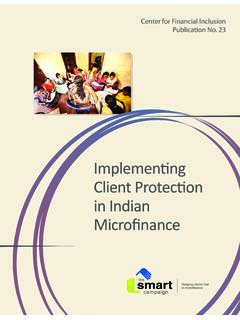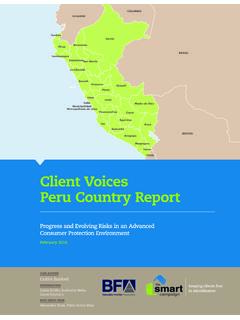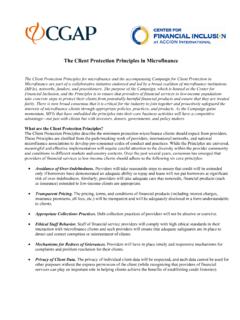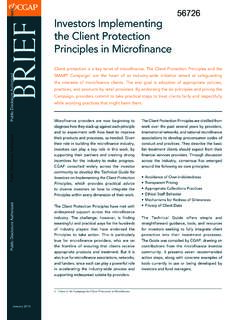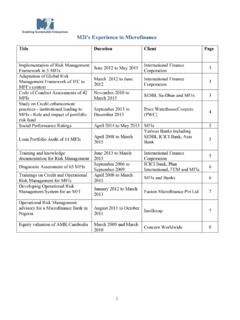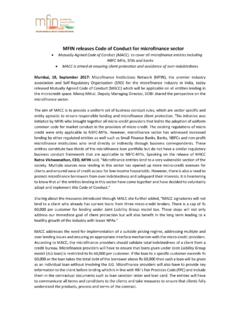Transcription of Digital Financial Services and Microfinance: State of Play
1 Digital Financial Services and microfinance : State of Play A framing note to inform the Evolution of the client protection Standards Lead Author: Sonia Arenaza, Director, Channels and Technology August 21st 2014 Collaboration between the Smart Campaign and the Accion Channels and Technology Team DFS and MFI August 2014 | Smart Campaign and C&T | Page 1 Digital Financial Services and microfinance Institutions Digital Financial Services and microfinance Institutions .. 2 1. Introduction .. 2 2. Purpose of this Note .. 2 3. Opportunities and Challenges for MFIs in Digital Financial Services .. 3 4. Role of MFIs in Digital Financial Services .. 4 a. State of play in deployments .. 4 b. The need for partnerships .. 5 c. What are the benefits for MFIs?
2 5 d. How can MFIs incorporate mobile banking? .. 6 e. What approach could MFIs take? .. 6 f. How are MFIs incorporating loan repayments, disbursement, and savings today? .. 7 g. How are MFIs acting as agents? .. 7 5. MFI Success Factors in implementing mobile banking .. 8 6. MFI challenges in the implementation of mobile banking .. 9 7. Raising risks to clients in implementation of mobile banking ..10 8. Annex A ..14 a. Partnerships: Deployments of mobile banking in MFIs .. 14 b. Terminology .. 16 9. Annex B The client protection Principles and Standards ..17 10. Annex C About the Authors ..18 Smart Campaign .. 18 Accion Channels and Technology Team .. 18 11. References ..18 DFS and MFI August 2014 | Smart Campaign and C&T | Page 2 Digital Financial Services and microfinance Institutions 1.
3 Introduction The client protection Standards were created to operationalize where the microfinance industry sets the bar in terms of the minimum behaviors clients should expect from institutions with which they do business. Building off of the seven client protection Principles (CPPs), the client protection Standards specify what doing no harm must entail in practice. The current 30 standards represent the output of several years of industry collaboration and input managed by the Smart Campaign (See Annex B for the complete list of the standards). For the standards released in January 2013 as part of the client protection Certification program, the Campaign worked with a Task Force of over 30 experts representing various stakeholders to develop and vet the recommendations.
4 The standards are truly a public good for and by the industry. Standards which reflect social norms and expectations of an evolving industry must be dynamic. In order to incorporate an ever-growing sector and its diversity of products, Services and related client- protection risks, the Smart Campaign has begun to work to evolve and improve its standards. One of the key directions of industry evolution is towards the use of Digital Financial Services (DFS). Therefore in partnership with the Accion Channels and Technology team, and under the management of an Evolution of Standards working group, the Smart Campaign began a work stream to understand the emerging risks to clients of Digital Financial Services and how best to mitigate those risks. Given the Smart Campaign s momentum of working directly with microfinance and Financial service providers since 2009, the workstream initially sought to understand the intersection of two big questions: What are the emerging risks to clients using Digital Financial Services ?
5 How do these risks align with the seven client protection Principles? How are microfinance providers using Digital Financial Services ? It is the intersection of these two key inquiries from which the first set of recommendations for the Evolution of the client protection standards will emerge. These recommendations will be shared publicly in late September 2014 for several months of open comment and feedback. These recommendations will then be discussed, debated and tested in the field for viability before becoming a permanent part of the standards and part of the client protection Certification Program. It is anticipated that most immediate application of these recommendations will be to microfinance institutions as part of the Certification program, however the Campaign firmly believes that the client protection Principles and standards are relevant and applicable to the wider ecosystem encompassed by all Digital Financial Services .
6 2. Purpose of this Note In the context of the Evolution of Standards of the Smart Campaign and its Digital Financial Services (DFS) work stream which analyzes the risks that the use of these Services poses to clients this paper aims to provide a deep dive into the intersection of DFS and microfinance . Since DFS covers mobile Financial Services and branchless banking1, it would be difficult to track exhaustively how microfinance institutions (MFIs) are using DFS. We have focused on branchless banking and mobile banking2, a component of DFS, because of the promising opportunities it presents for Financial institutions in reaching scale, leveraging existing deployments, and tapping into large populations at the base of the pyramid (BoP). 1 Delivery of Financial Services outside conventional branches by using technology channels such as cards, POS, ATMs, and mobile phones 2 Mobile banking, for the purpose of this research, incorporates mobile money and mobile payments DFS and MFI August 2014 | Smart Campaign and C&T | Page 3 Therefore, this desk research is intended to fill a knowledge gap in the intersection between DFS and MFI by providing an overview of the uses of DFS, especially with regards to mobile banking, and by answering the following questions: What is the role of MFIs in DFS?
7 Why is there a need for partnerships? What are the benefits for MFIs of implementing mobile banking? What are the most common DFS implemented by MFIs and how are MFIs implementing them? What are the key success factors and challenges? What are the risks to customers in implementing these Services ? Understanding the scale and use of DFS in MFI operations will help the Smart Campaign in narrowing the scope for its initial set of recommendations by understanding what is salient and being used in the field. Indeed this research will help the Smart Campaign be in a better position to improve the existing client protection Standards to pinpoint safeguards to minimize and mitigate against risks to clients when MFIs implement DFS. Building off this document, subsequent phases of the research will include a comprehensive client protection risk to matrix which, when combined with this note, will lead to key recommendations for service providers implementing DFS who strive to meet the Smart Campaign s principles of client protection .
8 3. Opportunities and Challenges for MFIs in Digital Financial Services The revolutionary use of mobile phones in emerging markets presents MFIs already providers of Financial Services to the BoP the opportunity to improve customer service to current customers by providing ubiquitous, safe and convenient ways to disburse and repay loans, save money, and check their balance; to increase customer outreach by bringing Services beyond brick and mortar branches; and to reduce operational costs or generate additional revenue which could be translated into a possible reduction in the interest rate. Therefore, there is the potential for to have more access to quality and affordable Financial Services . Evidence shows that mobile money deployments could help MFIs to improve operational efficiency, reduce costs, and better serve their existing customer base.
9 These Services though have been led mainly by mobile network operators (MNOs) and to some extent large banks. While MFIs are distinguished for their expertise in knowing clients needs and having high interaction with them; their success with large innovative technology projects or delivery channels is far less recognized. Of those MFIs that have successfully leveraged mobile banking, the majority are usually located in markets where the mobile service is widely used. Nonetheless, mobile banking involves the use of technology, non-cash transaction (in the form of electronic money complementing cash in and cash out transactions), and the participation of different actors with different levels of liabilities ( , MNOs, Financial institutions, agents, and third-party providers).
10 As such, mobile banking poses risks to clients ( , fraud, data privacy and security, service availability, hidden prices and fees, discrimination, insolvency, non-authorized ads, inadequate mechanisms for complaint resolution, etc.) risks a MFI should pay attention to in order to provide quality Services . MFIs can incorporate mobile banking into their business processes ( , loan disbursements, loan repayments, savings, and insurance) or act as agents of mobile money providers; MFIs are potential teammates if service providers want to tap into a large clientele at the BoP and/or work with patient agents aiming not only to acquire commissions. The third option pursued by few MFIs due to large resource requirements is to launch the service themselves either by designing and implementing the service in-house or partnering with a mobile solutions provider.
